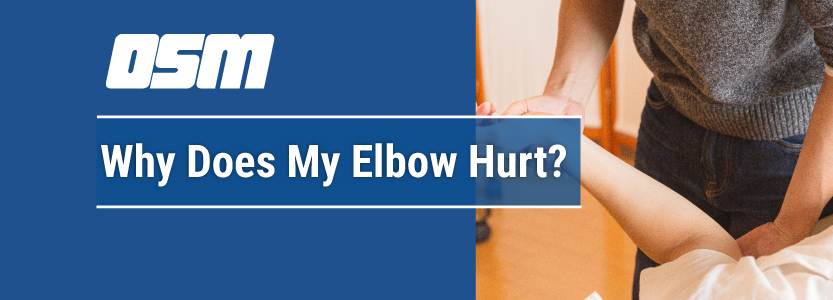Why Does My Elbow Hurt?
Article featured on WebMD
One-time Injuries
Some injuries, hopefully, are one-off events, like when you fall or get hit hard while playing a sport.
- Dislocated elbow. When one of the bones that forms the elbow gets knocked out of place, you have a dislocated elbow. One of the more common causes is when you put your hand out to catch yourself during a fall. It can also happen to toddlers when you swing them by their forearms — that’s called nursemaid’s elbow. If you think you or your child has a dislocated elbow, call your doctor right away.
- Fractured elbow: If one of your arm bones breaks at the elbow, you have a fracture. Usually, this happens with a sudden blow, as you might get in a contact sport or a car accident. And don’t be fooled if you can still move your elbow afterward. If you’re in pain and it doesn’t look right, it could be broken. You’ll need medical attention.
- Strains and sprains: File these under, “Oof, I think I pushed it a little too far.” When muscles get stretched or torn, it’s called a strain. When it’s ligaments, it’s a sprain.
Wear-and-Tear Injuries
Other injuries occur over time, as you repeat certain actions and put wear and tear on your elbow. You can injure yourself playing sports or in any number of work settings, from a factory to an office.
- Bursitis: Often caused by repeating the same motion over and over, you can also get bursitis from an accident or infection. Bursa are small sacs with fluid in them. You have them in your joints to help cushion your bones, tendons, and muscles. They also help skin slide over bone. But they can get swollen and cause you pain. Often, bursitis is simply treated with pain medicine and starts to get better within a few weeks.
- Tennis elbow and golfer’s elbow: These are both types of tendinopathy or tendinosis, which means you have damage in the tendons around your elbow from overuse. Despite the names, the injuries aren’t limited to golfers or tennis players. You’re just more likely to get them based on the arm motions used in those sports. The main difference between the two is that tennis elbow affects the outside of your elbow, while golfer’s elbow affects the inside.
- Trapped nerves: You might be familiar with carpal tunnel syndrome, where a nerve that passes through your wrist gets squeezed and causes some wrist and arm issues. You can have similar problems in your elbow.
- If you have radial tunnel syndrome, you have a similar issue with the radial nerve as it passes through the radial tunnel near the outside of your elbow. You may have burning or numbness on your outside forearm and elbow.
- Stress fractures: With a stress fracture, you have a small crack in one of your arm bones, usually from overuse. They’re more common in the lower legs and feet, but athletes who throw a lot, such as baseball pitchers, can get them in the elbow, too. The pain is usually worse when throwing.
Diseases
Several diseases can also cause elbow pain, though it’s usually not the main symptom.
- Arthritis: Many types of arthritis can affect your elbow, but the main ones are rheumatoid arthritis and osteoarthritis.
- Rheumatoid arthritis is the most common type of arthritis in the elbow. When you have it, your immune system attacks your body’s healthy tissue and causes swelling in your joints. You get osteoarthritis when your elbow cartilage breaks down over time, which means the bones rub together and cause pain and stiffness.
- Osteochondritis dissecans: Children and teenagers mostly get this condition, where a piece of bone near the elbow dies. The bone piece and some cartilage then break off, which causes pain during physical activity. It’s more common in the knees, but can happen in the elbow, as well.
- Gout: This is actually a type of arthritis. Uric acid, normally a waste product to be sent out of your body, builds up as crystals in your tissues. If the buildup happens in your elbow, it can be very painful.
- Lupus: This is another illness where your immune system attacks healthy parts of your body, including your joints and organs. It more commonly affects your hands and feet, but it can cause problems in your elbow.
- Lyme disease: Carried by ticks, Lyme disease can cause serious problems if not treated early. You may have issues with your nervous system and pain in your joints, like your elbow.
When to Call Your Doctor
If you think you’ve fractured or dislocated your elbow — it hurts and doesn’t look right — go to the emergency room.
Call your doctor if you have:
- Elbow pain that doesn’t go away with rest and ice, or pain that doesn’t go away even when you’re not using your arm
- Intense pain, swelling, and bruising around your elbow
- Pain, swelling, or redness that gets worse, especially if you have a fever, too
- Problems using your elbow, such as difficulty bending your arm
The Orthopedic & Sports Medicine Center of Oregon is an award-winning, board-certified orthopedic group located in downtown Portland Oregon. We utilize both surgical and nonsurgical means to treat musculoskeletal trauma, spine diseases, sports injuries, degenerative diseases, infections, tumors and congenital disorders.
Our mission is to return our patients back to pain-free mobility and full strength as quickly and painlessly as possible using both surgical and non-surgical orthopedic procedures.
Our expert physicians provide leading-edge, comprehensive care in the diagnosis and treatment of orthopedic conditions, including total joint replacement and sports medicine. We apply the latest state-of-the-art techniques in order to return our patients to their active lifestyle.
If you’re looking for compassionate, expert orthopedic surgeons in Portland Oregon, contact OSM today.
Phone:
503-224-8399
Address
17355 Lower Boones Ferry Rd Suite 100A
Lake Oswego, OR 97035
Hours
Monday–Friday



